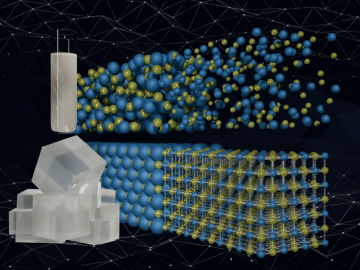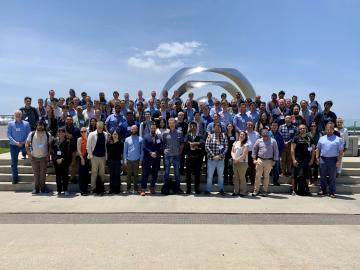
Filter News
Area of Research
- Advanced Manufacturing (1)
- Biology and Environment (10)
- Computational Engineering (1)
- Computer Science (7)
- Electricity and Smart Grid (1)
- Energy Science (18)
- Functional Materials for Energy (1)
- Fusion and Fission (1)
- Materials (29)
- Materials for Computing (3)
- National Security (13)
- Neutron Science (10)
- Quantum information Science (9)
- Supercomputing (43)
News Topics
- (-) Critical Materials (29)
- (-) Machine Learning (68)
- (-) Quantum Science (93)
- 3-D Printing/Advanced Manufacturing (146)
- Advanced Reactors (40)
- Artificial Intelligence (131)
- Big Data (79)
- Bioenergy (112)
- Biology (128)
- Biomedical (73)
- Biotechnology (39)
- Buildings (74)
- Chemical Sciences (86)
- Clean Water (33)
- Composites (35)
- Computer Science (226)
- Coronavirus (48)
- Cybersecurity (35)
- Education (5)
- Element Discovery (1)
- Emergency (4)
- Energy Storage (114)
- Environment (218)
- Exascale Computing (67)
- Fossil Energy (8)
- Frontier (64)
- Fusion (66)
- Grid (74)
- High-Performance Computing (130)
- Hydropower (12)
- Irradiation (3)
- Isotopes (62)
- ITER (9)
- Materials (157)
- Materials Science (158)
- Mathematics (12)
- Mercury (12)
- Microelectronics (4)
- Microscopy (56)
- Molten Salt (10)
- Nanotechnology (64)
- National Security (86)
- Neutron Science (171)
- Nuclear Energy (122)
- Partnerships (68)
- Physics (69)
- Polymers (35)
- Quantum Computing (53)
- Security (31)
- Simulation (65)
- Software (1)
- Space Exploration (26)
- Statistics (4)
- Summit (71)
- Transportation (103)
Media Contacts

Scientists have developed a new machine learning approach that accurately predicted critical and difficult-to-compute properties of molten salts, materials with diverse nuclear energy applications.

Members of the Quantum Science Center, or QSC, gathered at an all-hands meeting in Baton Rouge, Louisiana, in mid-May to reflect on the remarkable accomplishments from the past five years and to prepare for what members hope to be the next five years of the center.

Paul is exploring the next frontier: bridging quantum computing with neutron science. His research aims to integrate quantum algorithms with neutron scattering experiments, opening new possibilities for understanding materials at an atomic level.

The fifth annual Quantum Science Center, or QSC, Summer School at Purdue University, held Apr. 21 through Apr. 25, 2025, welcomed its largest group of students to date. Experts from industry, academia and national laboratories gathered at the Purdue Quantum Science and Engineering Institute to share their research in multiple areas of quantum science.

A research team from the Department of Energy’s Oak Ridge National Laboratory, in collaboration with North Carolina State University, has developed a simulation capable of predicting how tens of thousands of electrons move in materials in real time, or natural time rather than compute time.
Researchers at Oak Ridge National Laboratory have developed a modeling method that uses machine learning to accurately simulate electric grid behavior while protecting proprietary equipment details. The approach overcomes a key barrier to accurate grid modeling, helping utilities plan for future demand and prevent blackouts.

Working in collaboration with researchers from Oak Ridge National Laboratory, D-Wave Quantum Inc., a quantum computing systems, software and services provider, has shown its annealing quantum computing prototype has the potential to operate faster than the leading supercomputing systems.
Mariam Kiran, a quantum research scientist at the Department of Energy’s Oak Ridge National Laboratory, was recently honored as a finalist at the British Council’s Study U.K. Alumni Awards 2025, which celebrate the achievements of U.K. alumni worldwide.
Fehmi Yasin, inspired by a high school teacher, now researches quantum materials at Oak Ridge National Laboratory, aiming to transform information technology with advanced imaging techniques.
Daniel Jacobson, distinguished research scientist in the Biosciences Division at ORNL, has been elected a Fellow of the American Institute for Medical and Biological Engineering, or AIMBE, for his achievements in computational biology.


